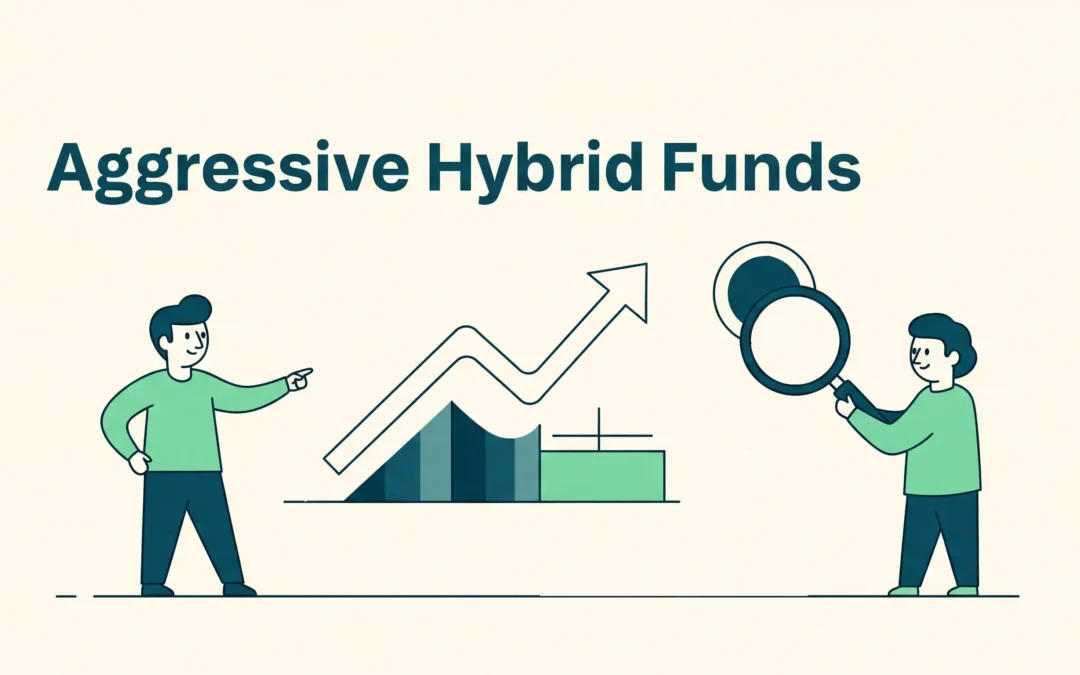When an individual starts their investing journey, identifying the fund that best suits their interest may be difficult. This is where aggressive hybrid funds come in. They are a mixture of both debt and equity, where equity investment is higher. The debt portion helps cushion against risk, but does not eliminate it. Aggressive hybrid funds generally offer higher return potential than pure debt funds over the long term, though returns are not guaranteed and can be lower than pure equity funds in some periods.
This article will help you understand the meaning of aggressive hybrid funds with a detailed guide containing pros and cons, key features, and some additional points that will help you decide whether it is suitable for you or not.
What Are Aggressive Hybrid Funds?
Mutual funds that invest in both debt (bonds or fixed income instruments) and equity (stocks) are known as aggressive hybrid funds. Their greater proportion of equity, typically between 65% and 80%, with the remaining 20–35% in debt, is what defines them as “aggressive.” This combination is intended to provide capital growth (from stocks) and some risk mitigation (from debt investments). Thus, you get a little bit of both stability and growth.
Key Features:
- Equity-Dominant: To increase returns, 65% to 80% of the fund is allocated to stocks.
- Debt Cushioning: To lessen volatility, 20% to 35% of assets are in debt instruments.
- Professionally Managed: The appropriate asset mix is actively chosen by fund managers.
- Perfect for the Medium Term: suited for investment horizons of three to five years.
- Tax Benefits: Taxed as equity funds (LTCG taxed at 10% above ₹1 lakh).
- Excellent for Beginners: Provides equity exposure to new investors at a lower risk than full equity funds.
Should You Invest in Aggressive Hybrid Funds?
Aggressive hybrid funds are unquestionably something to think about if you have a moderate risk tolerance and want to outperform savings accounts or fixed deposits.
They are particularly helpful to those who:
- Are new to investing.
- Want to buy stocks but are afraid of the high volatility.
- Are setting aside money for medium-term objectives, such as a vacation, a car purchase, or the creation of a starter portfolio.
Things to keep in mind:
- Recognise Your Risk Tolerance: Since 65 – 80% of these funds are in stocks, you must be able to handle short-term fluctuations. You might want to start small or think twice if you get anxious during market declines.
- The Investment Horizon Is Important: For a medium-term horizon (three to five years), these funds are perfect. Think about something more stable, like a debt mutual fund or fixed deposit, if you need the money within a year or less.
- Examine prior performance, but don’t rely solely on it: Examine the fund’s performance over the previous three to five years in a variety of market cycles. However, keep in mind that past performance does not necessarily indicate future outcomes.
- Examine the Fund Manager’s Performance History: The performance of your money can be significantly impacted by a dependable and knowledgeable fund manager. Check for openness, steady profits, and a track record of successful risk management.
- Examine and contrast expense ratios: The annual fee the fund house charges to manage your money is known as the expense ratio. Particularly over time, a lower expense ratio allows you to retain a larger portion of your profits.
- Don’t invest all of your money in one fund; instead, diversify: Diversifying across fund types or asset classes is still advisable to lower overall risk, even though aggressive hybrid funds are balanced.
- Recognise the Exit Load and Tax Regulations: If a fund is redeemed within a year, some charge an exit load. Additionally, even though it’s tax-efficient, understand the differences between short-term and long-term capital gains.
- Lump sum or SIP: For most investors, it is best to begin with a Systematic Investment Plan (SIP). Over time, it develops investment discipline and mitigates the effects of market volatility.
- Check for portfolio overlap: Make sure the stocks held by the funds don’t overlap too much if you currently own other equity mutual funds. Returns may be diluted by excessive diversification.
Pros and Cons of Aggressive Hybrid Funds
Pros
- Equitable exposure to debt and equity: Reduces overall risk by combining the stability of bonds with the growth potential of stocks.
- Managed Professionally: You don’t have to monitor or adjust asset allocation yourself; fund managers take care of it.
- Tax-efficient: Better tax advantages on long-term gains are provided by being treated like equity funds (over ₹1 lakh is taxed at 10%).
- Less volatility than funds that only invest in stocks: In times of market volatility or decline, the debt component helps even out returns.
- Excellent for medium-term financial objectives: works well for objectives that have a three to five-year time horizon, such as purchasing a car or saving for a vacation. For building an emergency fund, pure debt or liquid funds are more suitable due to their higher liquidity and capital safety.
Cons
- Carries market risk: Due to equity’s dominance, your capital is subject to fluctuations in the stock market.
- The debt component might underperform in periods of rising interest rates or credit stress, which can affect the overall fund performance.
- Short-term tax and exit load: A higher 15% short-term gain tax and exit loads could result from leaving the fund before a year has passed.
- Returns are not always guaranteed: Like all market-linked investments, aggressive hybrid funds do not guarantee returns or protection from losses. The value of investments can fluctuate based on market conditions
Bottomline
The conclusion can be drawn that aggressive hybrid funds are a good choice for people with less investing experience. The fund managers do the job of managing funds on behalf of people putting in their capital. These funds aim to balance the high return potential of equities with the relative stability of debt, though neither component guarantees returns or safety. However, it is advised to check the fund’s historical performance and align it with your risk profile and financial goals, rather than trying to predict future market movements.


